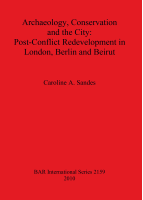Description
BOOK DESCRIPTIONThe aim of this research is two-fold: using aspects of London, Berlin and Beirut as templates, firstly it aims to examine the wider historical context of urban archaeological conservation in the post-war situation, and secondly to identify more clearly the reasons and values behind the conservation of archaeological sites within the modern city. From this a clear criteria may be drawn as to why such sites should or should not be conserved, and how they may best be considered and used in order that they may play an active and valuable role within the city. It is important to have such criteria relating to the valuing and decision-making regarding the conservation of sites so that the reasons for keeping such sites are more comprehensible to non-archaeologists, especially to the urban development professions, so that the sites' values may be better represented in their presentation. Due to the multi-disciplinary nature of this research and the on-going nature of, for example, redevelopment in Beirut, a variety of qualitative research methods were employed. These included desk-based research of urban planning and development history and theories; of the history, practice and theories of archaeology and conservation as they relate to the subject matter of this research; and also in a number of other subjects including history and cultural studies. In relation to the sites themselves, fieldwork was carried out in London, Berlin and Beirut; the author lives in London; Berlin was visited in March 2004, Beirut in April 2005, and both cities were visited again in 2007. There are six chapters. Chapter Two comprises a general historical and theoretical background of the urban context, and the practices of archaeology and conservation, along with a literature review. Chapter Two is followed by individual chapters on London, Berlin and Beirut. The case study chapters are each divided up into sections comprising the urban context, conservation and archaeology before and after the respective wars, the sites including how each site came to be conserved, and then a discussion. The final chapter draws together all the ideas and discoveries of Chapter Two and the case studies for the main discussion and analysis. It highlights the wide range of issues encountered in the cities concerned, demonstrating both similarities and differences of urban development and conservation of archaeological sites from post-World War II London, through post-World War II and then post-Cold War Berlin to post-war Beirut.











